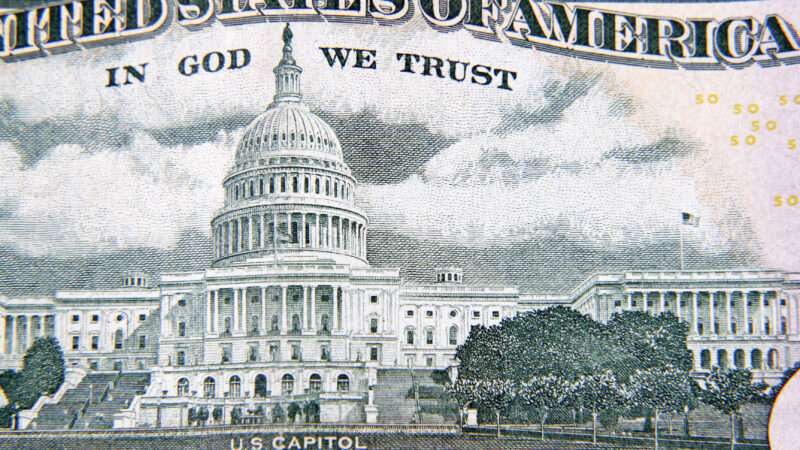
After a decadelong ban on the practice, members of Congress are once again loading up legislation with pork-barrel spending that the rest of us have to pay for.
The $1.5 trillion omnibus government funding bill that cleared the Senate on Thursday night (after passing the House earlier this week) marks the return of earmarks, spending that individual members of Congress can direct to their home districts. According to The Hill, citing a report being circulated among Senate Republicans, the 2,741-page bill includes more than 4,000 earmarks.
Sen. Mike Braun (R–Ind.), an earmark opponent whose office has been tallying up the projects included in the omnibus bill, claims the final total is about $8 billion.
That includes items like $3 million for a Palo Alto History Museum in California, according to a partial list of earmarks in the new legislation being compiled by Americans for Tax Reform, a conservative nonprofit. "The city is highly affluent and home to nine Forbes 400 billionaires," the group asks. "Why can't this be paid for with local or private dollars?"
A fair question, and one that could be equally asked of just about any earmark. Do federal taxpayers need to fund $800,000 for "artist lofts" in Pomona, California? Is there no other way to raise $3 million for a museum dedicated to Mahatma Gandhi in Texas or $500,000 to build a new ski jump in New Hampshire or $1.6 million to ensure "equitable growth of shellfish aquaculture" in Rhode Island? (Actually, yeah, it might be tough to attract private funding for that last one.)
According to the documents made public by Braun's office, Senate Majority Leader Chuck Schumer (D–N.Y.) appears to be one of the big winners in the latest earmark sweepstakes. Schumer's name is attached to 142 different projects, including $1.1 million for Sullivan County's "rail trail," $3 million for the Brooklyn Museum, and $1.5 million for capital improvements at St. George Theatre.
Yes, each of those items is only a few drops in the ocean of government spending, but they add up. And the bigger problem with earmarks has always been that they are secretive and opaque, often slipped into legislation with no public oversight or process for determining whether the spending is really needed. That makes them ripe for corruption—and suggests that lawmakers are well aware that many requests wouldn't stand up to scrutiny. It's often not even clear which lawmaker has requested what spending, which makes it difficult for voters to hold anyone accountable after the fact.
That's exactly why Congress outlawed the use of earmarks a decade ago after several high-profile scandals involving lawmakers steering public funds to pet projects for personal gain. Since then, some members of Congress and political observers have argued for a return of earmarks in order to grease the skids of government by providing a form of political currency for leaders to spend.
"It was only a small piece of it, but [earmarks were] something that you could do to bring that reluctant person along," Jonathan Rauch, a senior fellow at the Brookings Institution, told Reason in a 2015 interview. "When you lost it, both because of procedural changes and because the Tea Party said we're gonna vote against people who take earmarks, it was kind of in some ways the straw that broke the camel's back."
Other advocates for resurrecting earmarks promised that doling out pork could be done in a way that was more transparent and accountable. When the House Select Committee published a 2020 report proposing the return of earmarks—now to be known as "community-focused grants"—it promised that the new earmarks would be transparent, trackable online, and subject to greater scrutiny before being approved. The Select Committee's official recommendation is that those grants should be used only to support "meaningful and transformative investments in local communities."
"We laid out a framework that we thought could avoid some of the abuse of the past," Rep. Derek Kilmer (D–Wash.), the chairman of the Select Committee on the Modernization of Congress, told The Wall Street Journal in 2020.
Is that what we got in the omnibus? Hardly.
Instead, lawmakers rushed a 2,700-page bill through both the House and the Senate just days after the text was unveiled. There's no website tracking earmarks, no public process for connecting lawmakers to certain requests. Reporters and analysts have had to sift through the text of the bill to identify projects—which, again, are identified only by spending amounts and locations ($3 million for a history museum in Palo Alto, for example). Braun's office has helpfully published information about which members have requested which projects, but that's a far cry from the level of transparency that was promised.
"When lawmakers were pushing to bring earmarks back they promised unprecedented transparency, limits to projects, and greater scrutiny," Steve Ellis, president of Taxpayers for Common Sense, a spending watchdog group that works to expose waste, tells Reason. Ellis says his staff have been poring over "hardly legible, and certainly not sortable and searchable" documents provided by various congressional committees.
"I would be able to tell you more if Congress had actually produced a downloadable, searchable, sortable database of the sort we were promised," he says.
On Thursday night, Braun tried to amend the omnibus bill on the Senate floor to strip out some 367 pages of pork projects. The amendment failed, and the bill passed with a broadly bipartisan vote of 68–31, sending it to President Joe Biden's desk.
"This spending bill," Braun tweeted soon after the vote, "is a disgrace."
The post Earmarks Are Back, and They're Just as Sleazy and Secretive As Ever appeared first on Reason.com.







